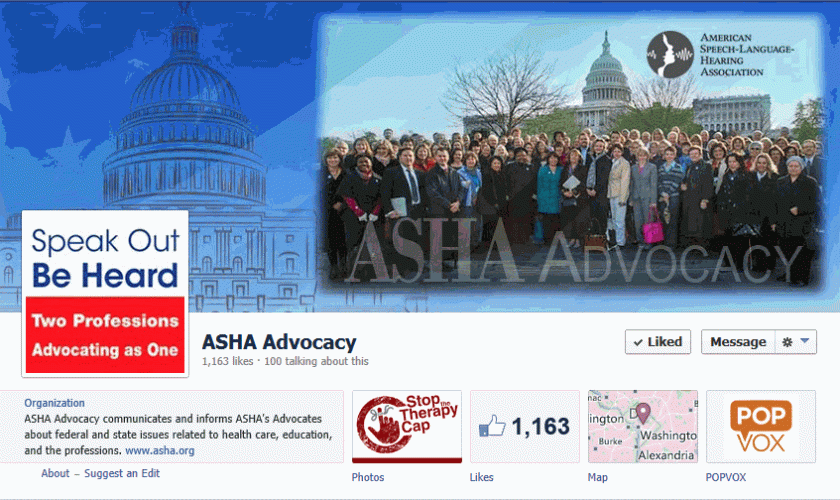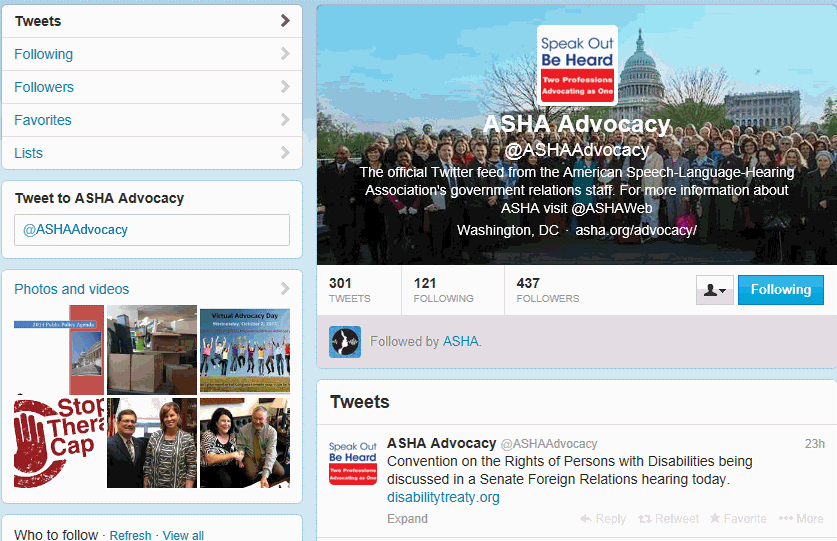I’m always talking about the need for associations to use social media in their advocacy efforts. With nearly every member of the House and Senate on at least one social network, there’s opportunity to push our issues beyond the traditional email action alert. Just this morning, I read a piece on how Members of Congress are starting to use Google+ and Google Hangouts in communicating with their constituents.
While some of us have been slow in implementation, others are diving into the deep end of the social media pool. The American Speech-Language-Hearing Association (ASHA) is one of those groups. Recently, I had a chance to talk to Caroline Goncalves, Associate Director of Federal Advocacy in ASHA’s Capitol Hill office about how they use social media tools in their advocacy efforts.
Association Advocacy Chick: Describe your position with ASHA?
Caroline Goncalves: I am the associate director of Federal Advocacy at ASHA. I primarily deal with the association’s grassroots programs such as running our take action site and facilitating member hill days. A large part of my job is encouraging member engagement in ASHA’s federal advocacy issues and I thought there was an opportunity to reach more members by harnessing the power of social media.
AAC: Do you work with ASHA’s communications department and/or web team on social media?
CG: ASHA has a social media manager who runs all of ASHA’s primary social media accounts and ASHA’s online community. The ASHA Advocacy social media team works closely with her for advice on best practices and collaboration. As well, we are members of a larger social media liaisons group within ASHA which gets together on a bimonthly basis to share new developments in social media, successes we’ve had and what has not worked as well.
If there is a particularly important message we want out there, an action alert for example, we will ask the social media manager to share it on the main ASHA social media pages to increase our reach and get an even bigger audience involved.
AAC: How did the Facebook page come about?
CG: After attending some briefings and information sessions about how social media can be used to enhance your advocacy efforts we decided this was an opportunity we should pursue. As mentioned, ASHA already had several successful social media channels but after some discussions we thought that the government relations and public policy cluster at ASHA had enough content to build our own page and reach out to an audience who was interested in learning more about and participating in advocacy matters related to federal, state, and health care advocacy issues.
Since much of our work is fast-moving and could need immediate action, this page also allowed us the flexibility to post urgent happenings immediately and get the information out there when we need to. Unlike the main ASHA Facebook page where the posts are scheduled sometimes weeks in advance and it could be a struggle to get our messages out in a timely fashion.
AAC: You also have a Twitter account. How do you communicate your advocacy efforts in 140 characters?
Twitter’s character count takes some creativity to convey an effective message but we always seem to figure it out. You need to be able to catch someone’s attention with the limited space that you have. That means mentioning the most important thing that they need to know and how this issue will affect their daily life and their profession. A catchy hashtag doesn’t hurt as well. We will almost always include a link for more information so that a member can take action or find more resources on the issue.
AAC: Talk about using Pinterest in your advocacy efforts.
CG: Pinterest is the fastest growing social network that ASHA Advocacy is on. The number of followers has by far passed any of the other social media avenues. The caveat to setting up the Pinterest site is that it’s hard to find images to post, which makes it the most difficult to maintain. However, our Pinterest followers are really engaged. Everything that we have ever posted has been repined or liked, so we know it’s worth it. We’ve gotten creative by posting screen shots of webpages to drive members back to the website or action alerts and try to have our graphics team design some infographics to post. Those always do well.
In addition, it is a well-known fact that Pinterest is most popular with women, which is the majority of our membership and why it’s been so effective for ASHA. It may not be the right choice for all associations, especially if they have a larger male membership.
AAC: What lessons have you learned about advocacy and social media that other associations can benefit from?
CG: You should be using every platform at your disposal to be engaging members in advocacy and social media is an easy and effective way to do so. Many people have email overload and it can be harder to reach them through a traditional email message because you may be sent straight to the trash with the other 20 emails they are sorting through and don’t have time to read. However, if someone is already on social media and happens to see your post while scrolling, you might catch them and get them interested and involved in advocacy. Even better if our post is shared by a friend or colleague of theirs because it seems more authentic coming from a trusted source, if their friend thinks it’s important maybe they should too.
We’re also building an educated audience and letting them know about issues as they’re happening, not just when we need them to do something. We hope this means when it is time to ask them to take action, they are more willing to do so because they know what’s at stake.
Finally, we’ve found social media to be a great tool to communicate quickly with our audience, but also to answer their questions. We can immediately respond to questions a member may have and it’s visible to another member who may have had the same question. It can start a discussion with members about an issue which is valuable to us as it gives us feedback about how members feel and if we are doing the best job we can to effectively communicate what they need to know.


